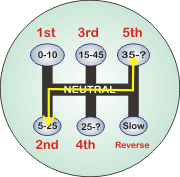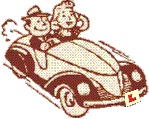Using gears to go!
 Some drivers always change through the gears one-by-one (1,2,3,4,5 - 5,4,3,2,1).
Some drivers always change through the gears one-by-one (1,2,3,4,5 - 5,4,3,2,1).
This is a habit that has stuck with some older drivers from when they originally learned to drive and was commonly taught well into the late 1990s. However, it is not generally good practice to use the gears in this way when driving modern motor cars.
Over the years, motor car design and engineering has improved. Compared with cars of even thirty years ago, modern vehicles more powerful and more aerodynamic and have braking systems that are fare mor efficient.
These changes (and others) mean that the driving method that was essential in older cars is not applicable to modern driving.
Because cars used to have braking systems were not as efficient as they now are, it was necessary to use the gears (or to be more precise, the engine compression) to help to slow the car down. Even though modern cars tend to be bigger and heavier than older cars they are equipped with very powerful braking systems that do not need engine compression to help them to slow down.
The efficient braking systems now enable drivers to slow down without the need to change to a lower gear.
Gear changes are made when power is needed to keep the car moving. This means that if you are stopping, you don't need to change gear until after you have stopped. This is the preferred method of the UK Driver and Vehicle Standards Agency and all advanced driving organisations.
 Missing out gears
Missing out gears
It is not necessary to change gears in sequence.
For example: If you are driving along a major road at 60mph in 4th or 5th gear, and you intend to turn left into a minor road, you may be able to do so without having to stop, probably using 2nd gear.
As you approach the junction, reduce your speed by deceleration and braking as required until you are going slowly enough to negotiate the junction safely - then change gear.
It is only after you have slowed down to a safe speed by using the brakes, that you need to select a gear that will drive the car comfortably at the lower speed. In most cars the best gear for the job will be 2nd.
The correct action is to move the gear lever into the neutral position and then directly to the second gear position.
You can also skip gears when changing up. A typical upward skip might be from 3rd to 5th on an open road.
Skilled drivers do not 'overlap' brakes and gears. This means that they finish braking and release the brake pedal before pressing the clutch and making the gear change - this leaves the right foot free for the gas pedal when the clutch is engaged.
The modern way
 Modern motor cars are designed to be driven in the way outlined above.
Modern motor cars are designed to be driven in the way outlined above.
Driving in this way is not only more economical, there are also several safety benefits relating to driver concentration, fatigue, vehicle control and so on.
The combined benefits make this a more efficient method than the old one-by-one sequential gear changing method.
Next: Step3 - Your gear change practise projects.